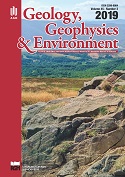Results of the comprehensive interpretation of well logs in carbonate and siliciclastic rocks – similarities and differences in the case studies of selected formations
DOI:
https://doi.org/10.7494/geol.2019.45.3.163Keywords:
comprehensive interpretation of well logs, carbonates, siliciclastic rocks, Cuban oilfield area, Carpathian ForedeepAbstract
This paper was made using geological and well logging data from the Cuban oilfield area and the Polish Carpathian Foredeep gas deposit to compare the interpretation process and underline similarities and differences between data analysis from two reservoir rocks of different lithology. Data from conventional hydrocarbon deposits, i.e. the Mesozoic Cuban carbonate formation and Miocene shaly-sandy sediments were processed and interpreted using Techlog (Schlumberger Co.) software. Selected approaches were used to determine the step by step volume of shale, total and effective porosity, water/hydrocarbon saturation (Quanti) and for the comprehensive interpretation of well logs (Quanti Elan). Brief characteristics of the carbonate and siliciclastic formations were presented to indicate that the interpretation methodology oriented to the determination of petrophysical properties depends strongly on the type of reservoir. Cross-plots were presented for primary mineral composition recognition, determination of m exponent and resistivity of formation water in the Archie equation. Effective intervals for the carbonate reservoir were calculated according to the Cumulative Hydrocarbon Column methodology. Finally, the results of the interpretation of well logs were presented as continuous curves of mineral composition, including shaliness, porosity and hydrocarbon saturation. The conclusions included recommendations for the effective comprehensive interpretation of well logs in the carbonate and siliciclastic reservoirs.
Downloads
References
Aguilera R., 1980. Naturally Fractured Reservoir. Petroleum Publishing Company.
Akhir N.A.M., Gaafar G.R. & Saaid I.M., 2015. Quantification of clay mineral and log response toward reservoir rock properties. [in:] ICIPEG 2014: Proceedings of the International Conference on Integrated Petroleum Engineering and Geosciences, Springer, Singapore, 221–231.
Archie G.E., 1942. The Electrical Resistivity Log as an Aid in Determining Some Reservoirs Characteristics. Transactions of the AIME, 146, SPE-942054-G, Society of Petroleum Engineers.
Asquith G. & Krygowski D., 2004. Basic Well Log Analysis. AAPG Methods in Exploration Series, 16, Oklahoma, USA.
Ballay R.E., Roy R. & Cox E., 2005. Formation Evaluation: Carbonate versus Sandstone. Robert Ballay LLC.
Castro O., 1992. Evaluación de las Formaciones Gaspetroliferas en las UTE Placetas-Camajuani de la región Habana Matanzas, por investigaciones de pozo. Library of Technological University of Havana, Havana [in Ph.D.Thesis of J.A.Echeverría].
Computing Petrophysical cut off, 2015, [on-line] www.geol-oil.com/petroCutoffs.php.htm [access: February 2019].
Crain P., 2002. Crain’s Petrophysical Handbook. [on-line:] https://www.spec2000.net/00-index.htm [access: Februar y 2019].
Filo M., 2006–2007. Trzciana-Cierpisz-Zaczernie3D – Re-port of seismic investigations of Geofizyka Kraków Sp. z o.o. Archives of Geofizyka Kraków.
Folk L.R., 1980. Petrology of Sedimentary Rocks. Hemphill Publishing Company, Austin, Texas, USA.
Jarzyna J., Bała M. & Zorski T., 1999. Metody geofizyki otworowej: pomiary i interpretacja. Uczelniane Wydawnictwa Naukowo-Dydaktyczne AGH, Kraków.
Karnkowski P., 1999. Oil and Gas Deposits in Poland. Geosynoptics Society Geos, Krakow.
Klaja J. & Dudek L., 2016. Geological interpretation of spectral gamma ray (SGR) logging in selected boreholes. Nafta-Gaz, 72, 1, 3–14.
Log Interpretation Principles and Application, Schlumberger, 1989. [on-line:] https://www.slb.com/resources/publi-cations/books/lipa.aspx [access: February 2019].
López O., Tavarez D., Alberto H., Dominguez R., Prol J., Baños N.S., Tamayo Y., Veiga C., César R.O. & Arriaza G.L., 2012. Interpretación parcial de la sísmica 3D, área Varadero-Seboruco. Digital Archives, Oil Research Centre (CEINPET), Havana, Cuba.
López O., Delgado O., Castro O., Blanco S., Morales C. & Ta-mayo Y., 2015. Play de Arenas del Oxfordiano (Hipotético). Digital Archives. Oil Research Centre (CEINPET), Havana, Cuba.
Montaron B., 2005. Reinventing Carbonate Petrophysics. Oil-field Review, Schlumberger.
Moretti I., Tenreyro R., Linares E., Lopez J.G., Letouzey J., Magnier C., Gaumet F., Lecomte J.C., Lopez J.O. & Zi-mine S., 2003. Petroleum system of the Cuban northwest offshore zone [in:] Bartolini C., Buffler R.T. & Blick-wede J. (eds.), The Circum-Gulf of Mexico and the Carib-bean: Hydrocarbon habitats, basin formation, and plate tectonics, AAPG Memoir, 79, American Association of Petroleum Geologists, 675–696.
Niepsuj M. & Krakowska P., 2012. Analysis and modelling of petrophysical parameters of the Main Dolomite formation on the basis of well logging and seismic data. Geology, Geophysics & Environment, 38, 3, 317–327.
Nosal J. & Semyrka R., 2012. Underground CO2 storage –case study of Jastrząbka Stara structure, SE Poland. Geology, Geophysics & Environment, 38, 3, 329–338.
Plewa M. & Plewa S., 1992. Petrofizyka. Wydawnictwa Geologiczne, Warszawa.
Schön J.H., 2011. Physical Properties of Rocks – A Workbook. Handbook of Petroleum Exploration and Production, 8, Elsevier.
Serra O., 1984. Fundamentals of Well-Log Interpretation: The Acquisition of Logging Data. Elsevier, Amsterdam – Oxford – New York – Tokyo.
Syrek-Moryc C., 2006. The deposit of natural gas Cierpisz as an important point in the issues concerning the future search in the thin strata of Miocene deposits of the Carpathian Foredeep and potential natural gas resources connected with the deposits. [i n:] Międzynarodowa Konferencja Naukowo-Techniczna Geopetrol 2006 nt. Problemy techniczne i technologiczne pozyskiwania węglowodorów a zrównoważony rozwój gospodarki: Zakopane, 18–21.09.2006, Prace Instytutu Nafty i Gazu, 137, Instytut Nafty i Gazu, Kraków, 18.
Techlog Online Help, Schlumberger Co., 2015. [on-line:] https://www.software.slb.com/products/techlog/tech-log-2015 [access: February 2019].
Downloads
Published
Issue
Section
License
Authors have full copyright and property rights to their work. Their copyrights to store the work, duplicate it in printing (as well as in the form of a digital CD recording), to make it available in the digital form, on the Internet and putting into circulation multiplied copies of the work worldwide are unlimited.
The content of the journal is freely available according to the Creative Commons License Attribution 4.0 International (CC BY 4.0)










